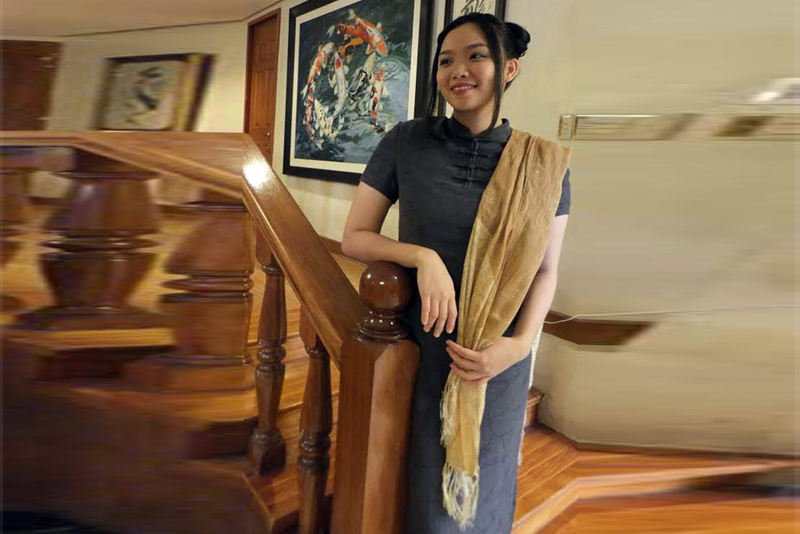The Qipao comes of age

Scarves add color and style to the modern Chinese look.
MANILA, Philippines — Years ago, the Chinese qipao or cheongsam was the look only entertainment personalities in Taiwan and China who had perfect figures could get away with. The glamorous women actually slipped into their tight-fitting Chinese dresses often enough to flaunt their whistlebait figures for the public to admire.
The high and standing collar, the seductive slits on the skirt and the figure-hugging cut certainly did not lend the Chinese costume to everyday wear. Brides, who used to be required by Chinese tradition to look like Chinese dolls in dazzling Chinese costumes on their wedding day, literally struggled to keep their poise at wedding banquets.
But the qipao or “banner dress” dating back to the years of Manchu rule in Chinese history has gone through changes in the last two decades or even longer so as to gain acceptance as something chic and wearable in even the very fashionable circles of modern society.
Today the woman who wears the stylized cheongsam with the Long Deed Taiwanese label shines in the company of wearers of creations from the top Paris fashion houses. Buying an exquisite qipao has become a sound fashion investment. The Chinese dress created by the inspired and extremely experienced designer Tsai Meng-hsia does not easily go out of style.
As a fashion design student at the Shih Chien College in Taipei back in the early 1960s, Tsai Meng-hsia loved the sessions devoted to drawing fashion ideas for submission to the teacher. Her creative output far exceeded the class requirement. In fact, she ended up secretly helping her classmates meet the deadline by offering some of her work and passing them off as her classmates’ projects.
“Back in those days,” recalled Tsai of Zhanghua in Central Taiwan, “Shieh Tung-min, the president of Shih Chien College in Taipei, earnestly urged us students taking up the newly offered course in fashion design to come up with a typical, modern Chinese costume.”
Those words went on to acquire deeper meaning with the passing of the years.
“Black and white television invaded homes in Taiwan in the early 1970s,” remembers Tsai. “I used to watch covered public functions on television. Women in chic qipaos flitted across the screen before me. Small breasts and big tummies added up to unsightly gourd shapes. The proportions were simply not right.”
In the beginning, Tsai was convinced that only entertainment stars were blessed with the physical attributes perfect for wearing the Chinese costume. But Shieh Tung-min’s words kept returning to prod Tsai to do something to remedy the picture.
Tsai decided back in the early 1970s, when she was ready to launch her own label from her home and workplace in Taipei, that she would work at revolutionizing the qipao to enable the young and the old alike to wear it with comfort and style.
The designer chose the name Long Deed for her label. The Chinese characters she selected were “lung” meaning “dragon” and “di” meaning “flute.” The images conjured by the name were right out of Chinese lore and legends. The name suggested magic and creativity.
Tsai did not hide her fascination with the Chinese symbol – the dragon. She also revealed her awe over the beautiful notes from the very simple Chinese musical instrument made of bamboo.
Tsai acted against the impractical idea of dressing up a woman in a traditional qipao, which did not allow her the freedom of movement. Wrapping up a woman tightly in a pretty package only made her a sorry sight, thought Tsai.
“I moved to transform the dress with Chinese collar and slits into a beautiful and practical fashion style,” Tsai pointed out. “I worked slowly at camouflaging the physical defects of the wearer. For example, I loosened the style a bit without spoiling the shapely silhouette. I actually enhanced it because I kept the unwanted bulges out of sight. I started making ready-to-wear qipaos in three standard sizes.”
And so Tsai began liberating the wearers of the Chinese cheongsam from the stifling, classic look. Tsai modified the qipao slowly and surely, taking care to still retain the Chinese features.
She introduced what could pass for the vested look. The waist was still defined to a certain extent, but the tummy was tucked away discreetly with the help of a semblance of an added garment layer.
The qipao used to be buttoned on the right side. Tsai went for the back zipper. The look was certainly easier to put on and remove.
Tsai also concentrated on another aspect of her design – color. Elegance and taste were what she tried to impart through her color schemes and color combinations.
Tsai was guided all along by trends in the world fashion capitals. Ideas from seasonal haute couture collections of Chanel, Christian Dior, Lacroix, Vuitton and Saint Laurent had a way of filtering down to the rag trade in Taiwan. Fabric choices could be dictated by developments on the international fashion front, too. Tsai tapped viscose, lace, wool, velvet and silk in her seasonal collections with at least a total of 200 new designs every year. The imported fabrics plus the needlework introduced to perk up the designs have a bearing on the costs and prices of the beautiful finished products.
The next time you go to Taiwan, buy yourself a Chinese qipao. You will surely turn heads when you wear it – to the office or to a party.
- Latest
- Trending














